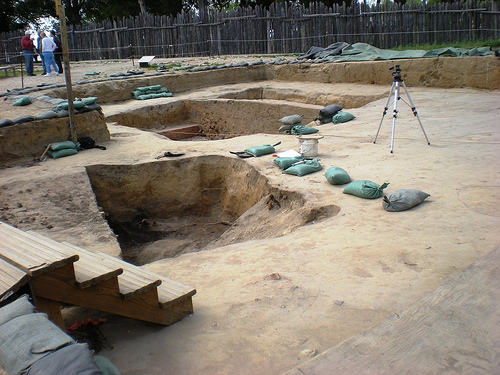Published on
When Research Gives You Answers to Questions You Didn’t Ask or Expect

When I began exploring the concept of identity and its co-correlation to motivation in distance education, I did not anticipate that my path would ultimately lead me here. Where is ‘here’? Here is an unknown place and way off the proverbial beaten track. Here is where I have found a way to target and utilize the various roles of the instructor to trigger self-efficacious learning behaviors in students.
Go back and re-read that last sentence. It’s a “whoa” moment.
This study resulted in the creation of the Instructor’s Engagement Rubric 1.0. This research will be presented at Sloan-C in Las Vegas on July 26, 2012. If you’re attending this internationally acclaimed conference, come by and say, “Hi!” If you are unable to attend, a conference paper on this research will published shortly there-after and you will be able to access the full IER 1.0 at that time. I welcome your interest!
While the study outcomes are unique and have attracted much attention, I find that a discussion of the process and what I didn’t expect to find to be just as valuable. Sure, I had a plan, I asked the questions, I had experts in on it with me… and still the raw data lead me to here; that unexpected place of whoa-dom. This is the place I’m going to take you.
If you’ve read any of my previous articles, you should be familiar with my writing style and layout—I begin with the obvious, line up my points with a heavy hit and light-hearted wit, and finish with a point. I’m stating that here so there is no confusion of my intent or approach (primarily because when people see the word research their eyes tend to glaze over and they go play Angry Birds. I get it, and I’ll make it worth your while).
This scope of inquiry began in fall of 2009 and as I whittled down my identity topic I began to focus on the purpose of my research. For those who have written a doctoral dissertation, you are aware that this is the point where a lot of people give up and go ABD (all-but-dissertation). I stuck it out because I am, by nature, a ravenously curious individual and got joyfully caught up in the smoke and mirrors of the unknown hunt. I was like a dog with a bone.
After gnawing on the concept for over a year, I came to this purpose:
To determine an actionable correlation among the variable separate components of this study: Transactional Distance, self-efficacy, and academic learning. Creation of Instructor’s Rubric 1.0:
- Instrumental in presenting the necessary formulaic practices for the instructor to trigger the domino effect of the above variables
- Propel the student toward increased academic learning.
Then I clarified my focus with this statement of the problem:
The drop-out rate in Transactional Distance based classrooms is dependent upon the quality and training of the persons facilitating the content.
Then I found these statistics. I gasped. (Full references available at publication)
- 70% drop-out rate with no/poor adequate faculty training
- 40% with some/better faculty training
Egad! Those are some heavy numbers.
It was at that point when my focus changed a bit and I started the journey that would define me for the next few years… What to do about those numbers? How to push the right buttons? Whose responsibility was it to learn: the instructors’ or the students’? How to make that happen?
So many questions tumbled around but I was finally able to focus it down to four specific thoughts with all of them running through the proven theory of transactional distance.
My research questions were broad in scope and narrow in outcome. I felt ready to get to the heart of this issue. My research questions were:
- What proportion of transactional distance variables of structure and dialogue are perceived by instructors as being most impactful on academic learning?
- What proportion of transactional distance variables are perceived by instructors to influence a learner’s increased academic learning self-efficacy?
- How does the instructor implement structure and dialogue to increase self-efficacious traits in the student?
- What purpose does the instructor have for implementing the instructor’s rubric?
After reading more studies, research, opinions, etc. on this topic than I ever thought possible, I came to the following conclusive realizations.
- The technological tools in the Transactional Distance classroom are being used in a variety of manners and with little consistency as to desired outcome.
- There is inconsistency with the identification of the role of the instructor in a TD classroom.
- There are certain combinations of tools and purposeful interactions that can create an improved learning environment for the student.
With all of that keeping me up at night, I decided to do what I do best; I tweaked my inquiry and decided to ask those regarded as experts for their experiences and input. I crafted a three round anonymous system of surveys following the Delphi Method of inquiry. To this day no one knows who answered what, how, or when – not even me.
For a list of criteria for inclusion in this study, please see the full research following the Sloan-C presentation in Las Vegas, July 26th. For now, here is the summary list of participants:
Distance education professionals:
- Instructors
- Researchers
- Theorists
- Administrators in University institutions
- Corporate directors involved in distance education and/or training
As stated in the above criteria for participation inclusion, biological age was not a determining factor for participation in this study as it was ‘experience based’.
After the survey rounds were administered, the data was collected, and the numbers quantified, some very odd patterns began to emerge. However, the most disturbing of all was the apparent lack of uniform practice, design, and utilization of the technologies within the distance education classroom.
Yep. Go back and re-read that. It took me quite some time to absorb the fact that there were no statistical strongholds, no clustering, no obvious patterns. Random data was the norm. My committee nearly had a collective heart attack. Now what?
Here is a quick summary of the published findings of two predominant themes that emerged in the raw data:
- The technological tools in the Transactional Distance classroom are being used in a variety of manners and with little consistency as to desired outcome.
- There is an apparent inconsistency with the identification of the role of the instructor in a Transactional Distance classroom.
So what else did the data show? The major findings of my research show:
- The primary findings indicate that the instructors experience different levels of “success” (as they perceive their experience with their individual students) based on which technologies are chosen for each role the instructor inhabits during the interaction.
- Apparent discovery that technologies currently in the higher education system are being mostly ignored, and at best under-utilized, by both the faculty and the students.
Oh boy. So what are the big picture implications of this research? So what are the recommendations going forward?
- This rubric is the first tool that provides a directional approach for instigating the self-efficacy traits within the framework of Transactional Distance environments.
- This rubric focuses on the needs of the student by providing communication direction starting at the instructor’s point of interaction.
- This is the first English theory combination study that utilizes The Delphi Method to merge the multiple points of inquiry into a single product of outcome.
- The need for a Student’s Rubric 2.0 is clearly evident.
- The introduction and utilization of the Instructor’s Rubric 1.0 will provide a road map for the successful development of Transactional Distance classrooms.
What does this not mean? It does not mean there is ill intent on behalf of the thousands of dedicated educators and administrators who have committed their life’s work to teaching, facilitating and implementing higher quality outcomes in their respective environments. It does not mean that they are slow, disinterested, or lagging in any way. It most certainly does not mean they don’t care.
It’s deeper than that.
What does all that mean? It means there is a lot to be worked on. It means that the experts do not have a uniform plan of action with regard to technology implementation in the classroom. It means that while there appears to be a need, very few are aware of the research and pedagogy necessary to purposefully trigger self-efficacious learning behaviors in their student populations. It means that while there are small pockets of brilliance across the globe, these are still small pockets of brilliance which are shared on a Best Practice scale at various venues with little regard to holistic adhesion. It means that a lot of slow down, step back and re-group work needs to be done. It means educators need to put the time and energy into defining what works for them and demanding that the technology corporations deliver that—rather than education simply buying into what the technology companies tell them they need.
That’s a lot of stuff that came out of my research. I was poking around in one direction—identity and motivation—and landed way, way off the beaten path. It’s somewhat scary out here and I’ve heard more than my share of wolves howling in the dark as I disturb the status quo.
Make no mistake; I’m not rebel rousing for the sake of a good angst party. I simply found myself asking questions in a direction that I thought would result in answers of the unified, comprehensive, and purposeful kind—what I found out could not be more different.
However, as my research gets out there and I have the conversations, the writing and speaking opportunities and the work comes in, I have to ask myself the obvious question: Is it worth it?
Yes. A thousand times yes. I can be brave when I have to be brave (spiders, bees and even snakes) but in this case I’m being brave because I want to. I want to share what I learned because I firmly believe it will help educators find their collective voice, their strengths and their mission to demand a unified front on behalf of their students. Did we all come to this crossroads in our lives with the desire to become passive in our goals?
Hardly! We are here, and you are reading this, because you care enough to dare to matter to that one student, in that one classroom, on that one day. I pushed forward down this undefined path because I knew—deep inside—that what I was uncovering could lead to a huge change in how things are done in the transactional classroom. Why? Because status quo, isolated and random best practices, and top down blockades are doing nobody any good. The students’ needs must come first—and we must propel them forward, beyond our reach, into their new self-efficacious selves.
Sometimes research doesn’t give you the answers you’re looking for. Sometimes it creates more questions than you originally thought possible, let alone relevant. Often you learn things you didn’t know were out there—sometimes the things you unearth aren’t pretty. Be willing to get dirty by being authentic, integrity bound, and inquisitive with passion. Trust your instincts to learn what is being shown to you, regardless of what you thought you were looking for.
I asked what, I found out why not, I learned the how and now I ask, will you?
Peace and good choices.
Author Perspective: Business



